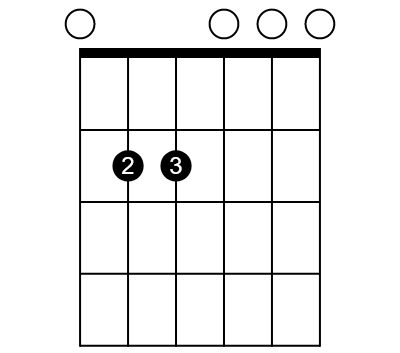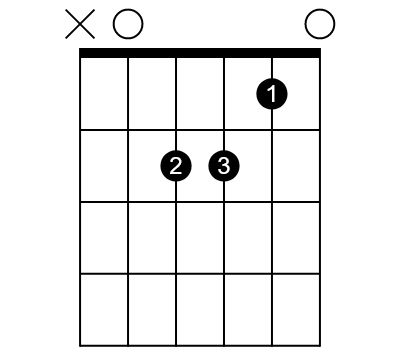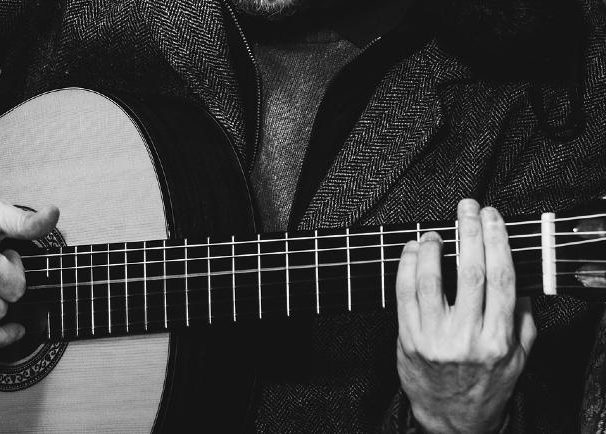
The guitar chords E minor and A minor are important in their own right. But even beyond those chords themselves, their shapes are among the most important shapes in all of guitar playing.
The guitar chords E minor, A minor, and D minor are the only common open minor chords
Some guitarists will stick to the most basic chords. Many will want to progress to more complex forms, but not everyone. Some of us just want to play simple parts to accompany ourselves or someone else as they sing.
This translates to mostly playing open chords. It’s a perfectly legitimate place to settle as a guitarist. But even if you’ve decided to stay basic, sooner or later you’re bound to run into a few minor chords that you can’t play with open positions.
Need to learn more about open chords?
In fact, only three minor chords have common, comfortable open positions. The guitar chords E minor, A minor, and D minor stand alone in that regard.
Even if you intend to stay at a basic playing level, you’re going to need more than these three minor chords. Luckily, you can turn the guitar chords E minor and A minor into any minor chord you need.
How do you play an E minor chord?

An E minor chord consists of the notes E, G, and B. This chord is one of the easiest of all chords to play on the guitar because it has a comfortable and simple open position. To play it, leave the Low E, G, B, and High E strings open. Push fret 2 of the A string with your middle finger for a B note. Add fret 2 of the D string with your ring finger for an E note. You can strum all six strings with this chord.
There are many other places on the neck where you can play an E minor chord. Any combination of the notes E, G, and B gives you an E minor. But the open E minor shape is critically important as we’ll see later in this article. You can use it to play any other minor chord.
How do you play an A minor chord?

An A minor chord consists of the notes A, C, and E. This is a very easy chord to play on guitar with a comfortable shape. To play it, leave the A and High E strings open. Push fret 1 of the B string with your pointer to play a C note. Press fret 2 of the D string with your middle finger for an E note. Play fret 2 of the G string with your ring finger for an A note. Omit the Low E string and strum the remaining five strings.
Again, this is an extremely important shape to know on the guitar since it enables you to play every other minor chord.
Why you need to know how to play other minor chords
If the chords E minor and A minor are so easy to play and sound so good, why do you need to know other minor chords?
The short answer is that every key–no matter if minor or major–contains minor chords. Not every song uses minor chords, but many do.
For instance, the key of G contains the chord A minor. It also contains B minor and E minor. So, if you encounter a song in the key of G that includes all of these minor chords, you’ll be just fine with open chords. That is, until you hit that B minor.
The key of E contains F# minor, G# minor, and C# minor. So there you have three minor chords that don’t have comfortable or common open positions.
I could go on. Every key contains minor chords. We already know that only three of those minor chords have common open positions. So you can see how badly not knowing how to play other minor chords will hamper your ability to play even at a basic level.
The guitar chords E minor and A minor are movable
So, you’ve got a lot of minor chords to learn, right? Well, yes. If you count the sharps and flats, then you have a total of 12 minor chords to learn. And so far, you only know three.
But it’s far easier than you think to play the rest. Since you know the shapes for open E minor and A minor, you already know most everything you need to know in order to play all of the minor chords.
And, these two shapes give you two different options for playing the full compliment of minor chords. We’ll call them the E minor shape and the A minor shape.
Both of these shapes are moveable. This means you can move the guitar chords E minor and A minor to any fret to make a different minor chord.
But how do you do that? How do you move these chords? You need to shift your fingering a bit in order to free up your first finger. You then use that first finger to bar across the open strings in order to raise their pitch.
Need to know more about bar (barre) chords?
The addition of this first-finger bar makes the E minor and A minor shapes moveable. Let’s take a closer look at both.
How to make E minor moveable
To make the E minor chord moveable, use your ring, and pinky fingers to press the strings. This leaves the pointer open and available to create the bar. And it leaves the middle finger available to help create the bar if you need a little extra strength.

This can be particularly helpful at the low frets. For instance, look back at the photo at the beginning of this page. Notice that the player is using his middle finger to provide a little extra strength since he’s barring at fret 1, which can be challenging.
As an example, say you want to make a G minor chord. To do so, use the first finger to bar across all six strings at fret 3. Push fret 5 of the A string with your ring finger and fret 5 of the D string with your pinky.
Strum all six strings and you have a G minor chord.
How to make A minor moveable

Similar to how you shifted fingers to make the E minor chord moveable, you do the same with the A minor. Just as with the E minor shape, you use the pointer to create the bar that makes the A minor shape moveable.
Let’s say you wan to make a C minor chord. Bar across the five highest strings with your pointer. Do not fret the Low E string.
Now, push fret 4 of the B string with your middle finger. Next, push fret 5 of the D string with your middle finger. And finally, push fret 5 of the G string with your ring finger.
How to find any minor chord you need
Just as you’ve done with the G minor and the C minor above, you can make every other minor chord. And you can use both shapes to make all of the chords. So you have some options to use the most convenient shape depending upon the song and the chords around the one you’re making.
But how do you know where to make these shapes for the specific chord you want to make? Easy. Just find your root note on either the Low E string or the A string. Once you find your root, make your bar at that fret and construct the rest of the chord from there.
Need help finding the notes on the E and A strings?
For instance, look back at the G minor. Since G is at fret 3 of the Low E string, we bar at fret 3 and then make the E minor shape above that bar.
It works the same way for the C minor. Since C sits at fret 3 of the A string, we bar at fret 3 and then make the A minor shape above the bar.
Let’s take a couple more examples. F# minor is a very common chord that’s used in many songs. To create this chord, first find the root note. We know it sits at fret 2 of the Low E string. So, bar fret 2 and make the E minor shape above the bar.
To make another very common minor chord, the C# minor, find the C# note at fret 4 of the A string. Bar at that fret and make the A minor shape above the bar.
Use the same procedure to make any other minor chord
And as I said, knowing both of these shapes gives you options. For instance, you already know you can make C minor at fret 3 with the A minor shaped bar chord. But you can also use the E minor shaped bar chord at fret 8 for another way to make a C minor chord.
And it works the other way too. You can play an F minor chord with the E minor shape at fret 1. Or, you can find F on the A string at fret 8 and use the A minor shape to create your F minor.
Just find the root note of the chord on either the Low E string or the A string. The string you find the root note on dictates which shape you use. For root notes on the E string, use the E minor shape. For root notes on the A string, use the A minor shape.
Conclusion
Only three minor chords have common and comfortable open shapes. But the guitar chords E minor and A minor give you moveable shapes that you can use to create any other minor chord.
Use your pointer to bar across five or six strings, and use your remaining fingers to make the E minor and A minor shapes. Depending upon where you make the bar, you can create any minor chord.
When the root note is on the Low E string, use the E minor shape to create the minor chord that corresponds with the root note. When the root is on the A string, use the A minor shape.
Since all keys contain minor chords, sooner or later you will run into a song that requires a minor chord other than the open ones. With these moveable bar-chord shapes, you can make every minor chord you need.

Your instruction on minor chords is a big help, written where I can understand it. Thanks a bunch!
That’s great to hear, Larry! I’m glad you found it helpful. Let me know what else you need help with.
Hey. Love the article and found it useful. Now, the same concept be applied to the ukulele minor chords? While I’m waiting for a reply let’s see if I can apply the same concept to the ukulele. Somehow I’m thinking it’s possible to do so but we’ll see real soon. Thanks.
Hi Sáne,
I’m certainly no expert Ukulele player, but in theory, yes, the same concept could apply. The Uke actually uses the exact same chord shapes as we use on the guitar only just the four thinnest strings of the guitar. Plus, because the Uke is tuned to different open notes, the same chord shapes result in different chords. For instance, to play a G on the Uke, you make the exact same shape as a D on Guitar.
Technically, any open chord can be a moveable shape (on guitar and uke) by adding a bar to the chord. So, you could make an A on the Uke by barring with your first finger at fret 2 and playing the G shape which would now be at fret 4 (instead of the normal fret 2 of the G chord). The same is true on guitar. If you bar at fret 2 and play the D shape, you’re playing an E chord.
So, in short, bar any of the open chords you know on Ukulele and you can move those shapes to make other chords. Both major and minor.
I’d love to hear back from you and learn the results of your own experimentation with this idea!
Reading your article was like being hit with a bolt of lightning!!
Cannot thank you enough. My repertoire of chords just took a major jump!! A very lucid and succinct explanation. You are a gifted teacher. Thanks again. God bless.
You can’t know how much it means to me to read your words, Gourishankar! I appreciate it so much and am very happy to hear you found the article helpful. Always feel free to let me know if there’s anything else I can write about that will help. Good luck on your guitar journey!